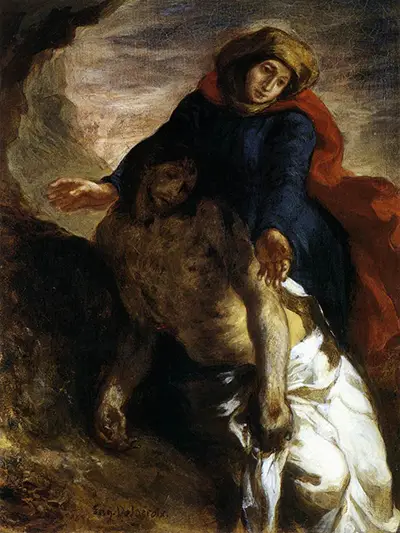 Buy Art Prints Now
Buy Art Prints Nowfrom Amazon
* As an Amazon Associate, and partner with Google Adsense and Ezoic, I earn from qualifying purchases.
Pieta is a small artwork produced by Eugene Delacroix in around 1850. It was made using oils, though the artist also regularly used watercolours in other periods of his long and distinguished career.
Delacroix had earlier produced a depiction of the deposition of Christ in the 1840s, and later produced this simplified version. Here we find just two figures, with Christ hunched over in the darkness. At the very back is a setting sun, providing just enough light for us to see the detail in front of us. The mood perfectly suits the content, as a figure dressed in red and blue looks over the iconic religious man. Christ himself is dressed in white cloths, much of which is ripped and hanging limply around his body. He is skinny, devoid of life and seemingly desperate. This emotional scene would be used by other artists in their own careers and Christ's life more generally was highly prominent in the centuries prior to the French Romancitist era, partly due to its dominance of western society.
Mary is, of course, the figure mouring in this scene as she considers the corpse of Christ in this touching and upsetting scene. Mny other interpretations of Pieta have added all manner of other figures into each composition, and there is also a very famous sculpture of Pieta produced by Michelangelo. We find very bold colours in Delacroix's version which was typical of the journey he was on at the time. This technical approach with rougher brushstrokes would also interest later artists, with some taking the methods into their own careers as the Romanticist era continued to influence for several centuries into the future. Interestingly, there was also a copy of this work produced by Van Gogh, as he attempted to learn more about this expressive style which helped to bring about change in European art.
Pieta by Eugene Delacroix can be found in the National Museum in Oslo, Norway. This venue is best known for hosting one of The Scream series by Edvard Munch, though there is plenty else to see within their impressive collection. They have a strong focus on Norwegian art, as one would expect, and cover both painting and sculpture is considerable detail. This dark but beautiful country has a unique landscape which has understandably inspired many artists over the years, with some foreign artists travelling here to enjoy some of these scenes themselves. Munch is the figurehead of the region's art history offering, and has since been given a specialist museum of his own which includes many artworks left in his possession at the time of his death. By comparison, the likes of Delacroix is simply another world regarded artist from France, which has produced many different art movements of its own in previous centuries.



